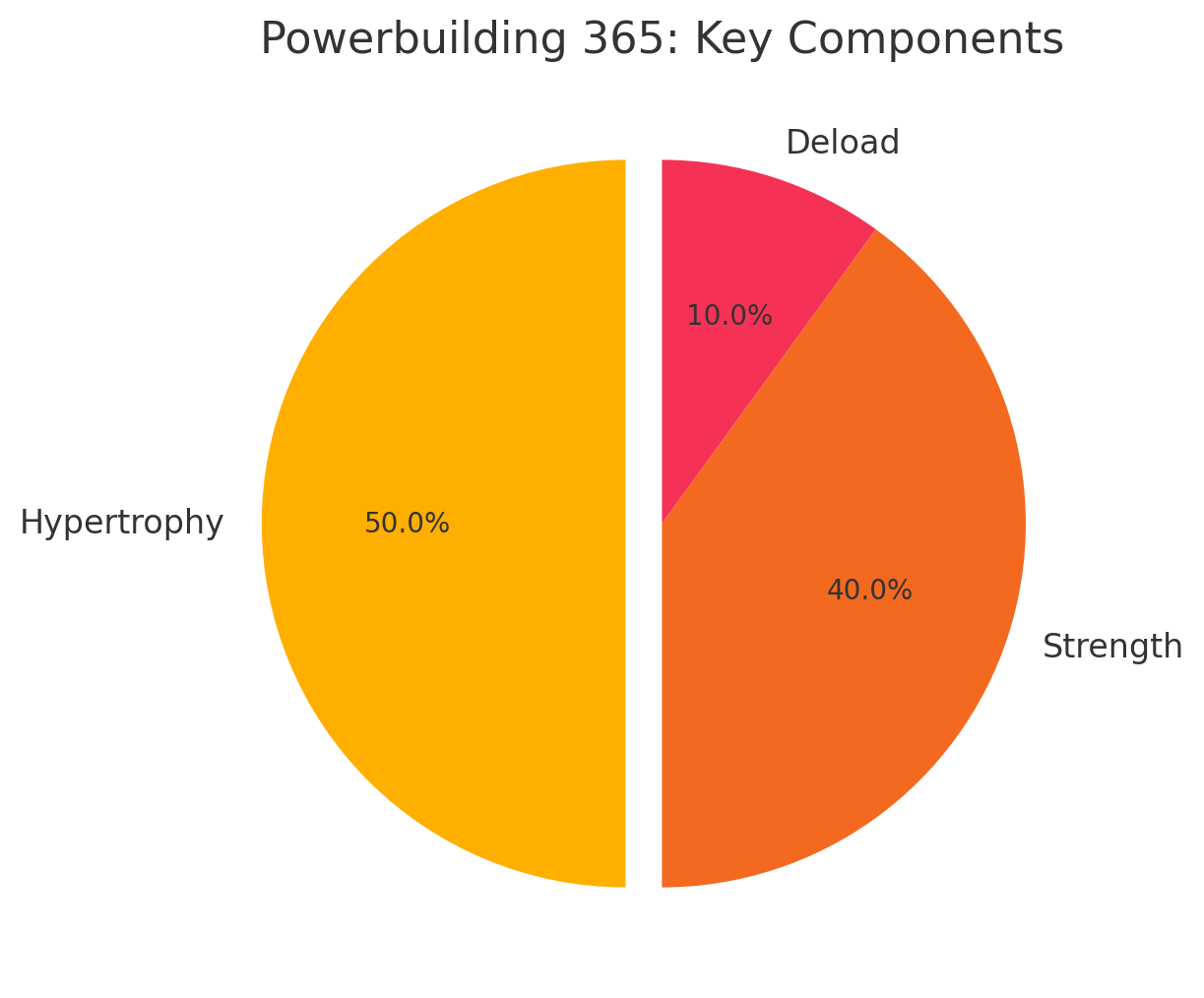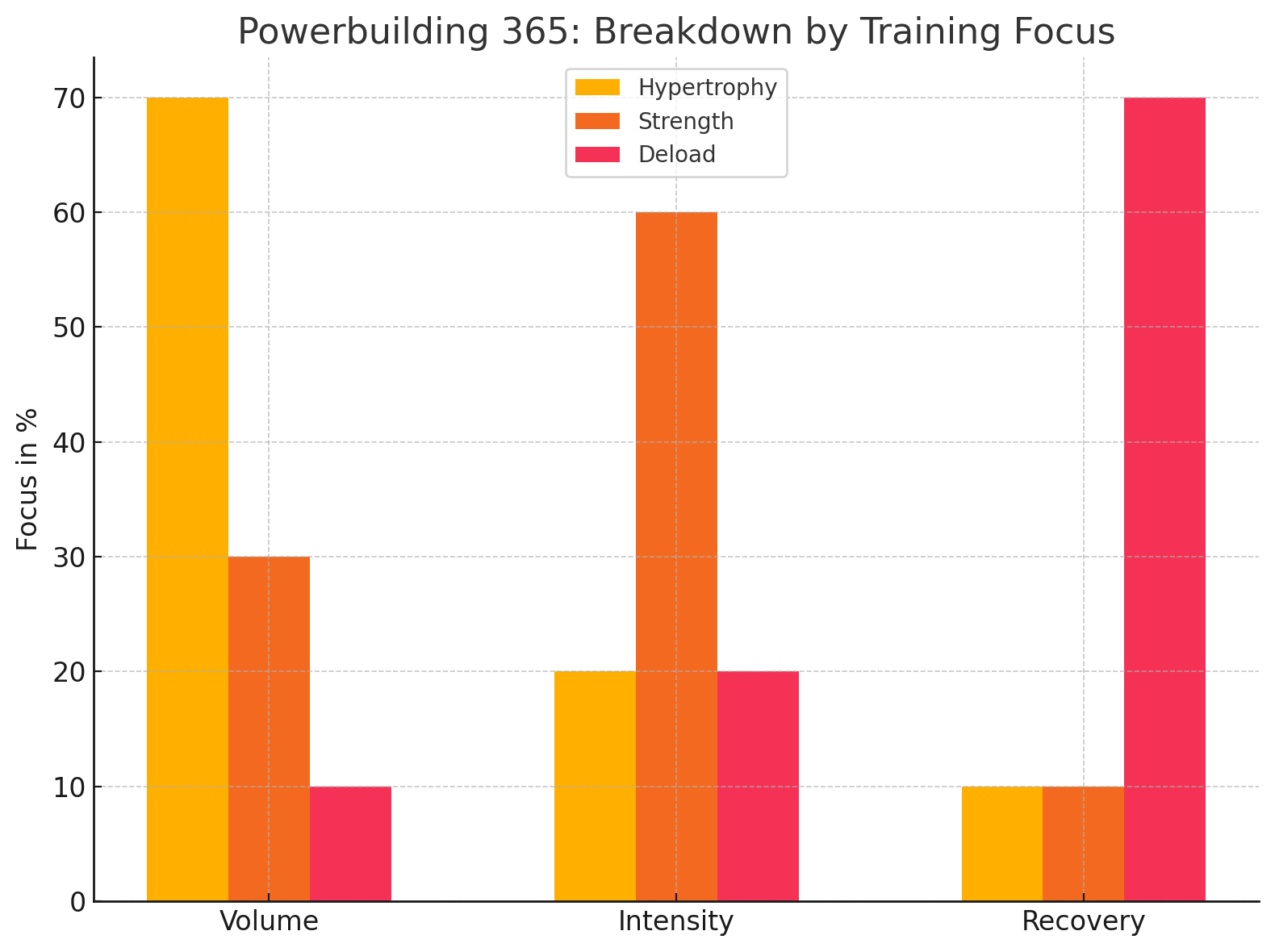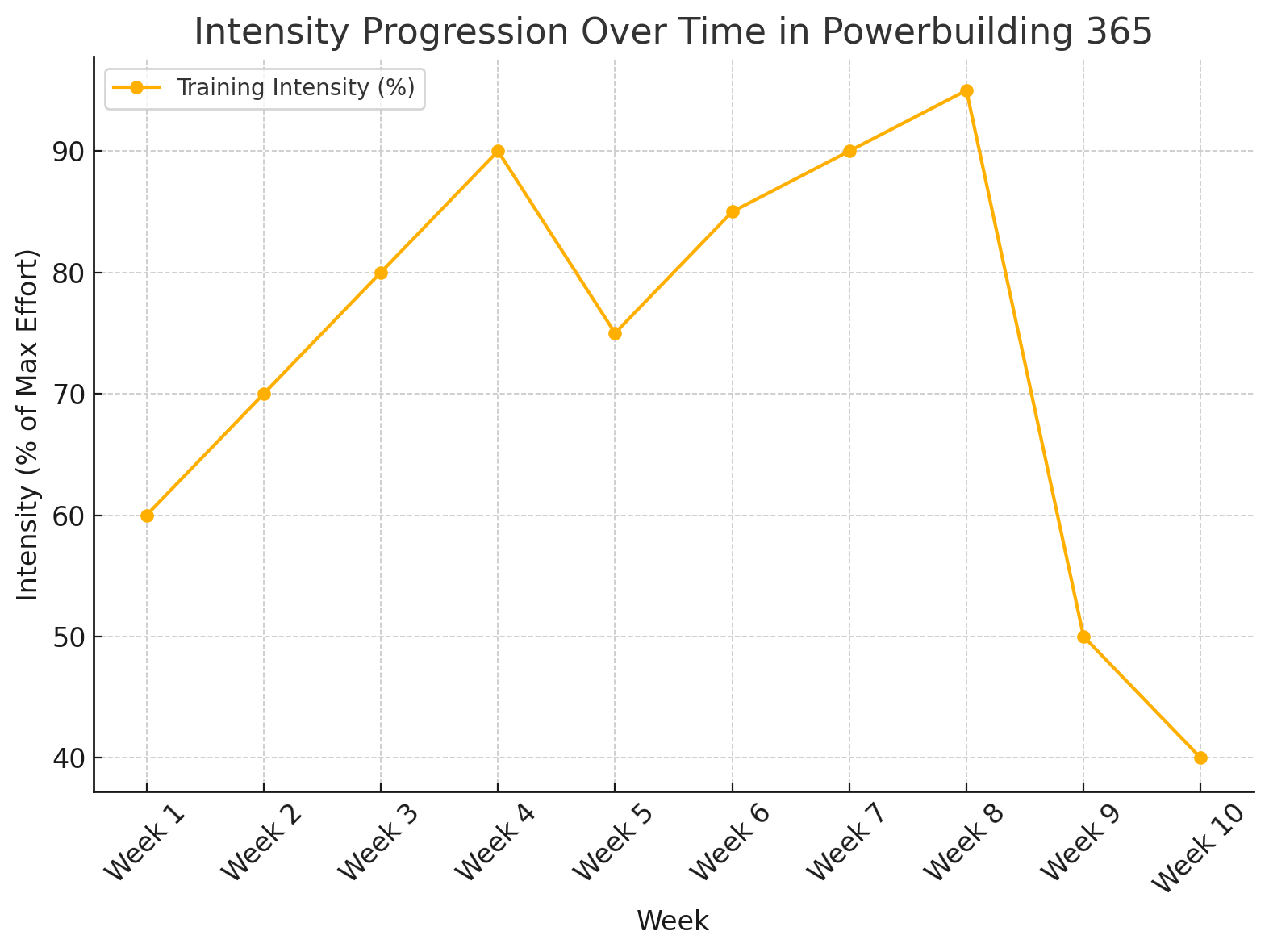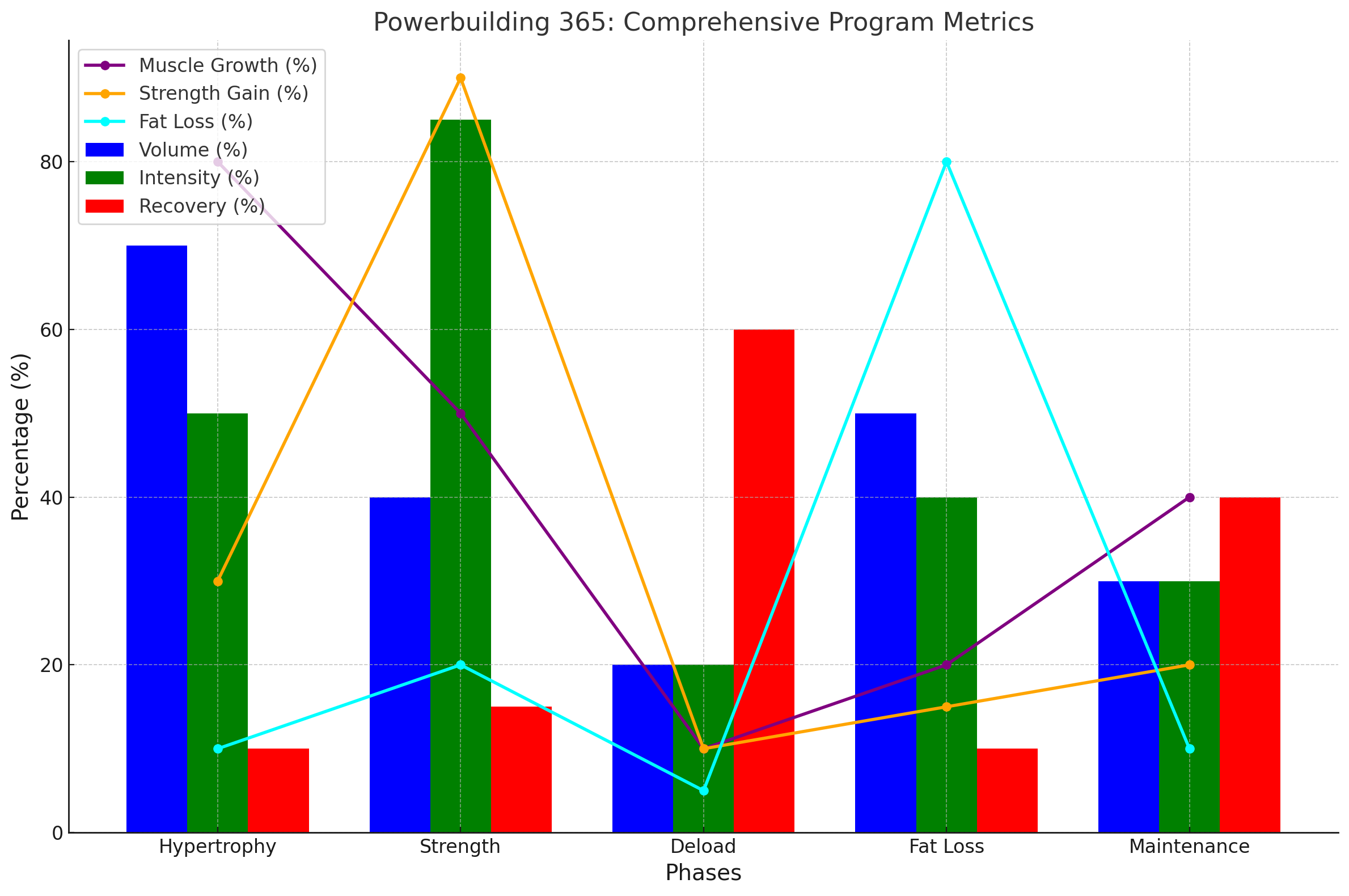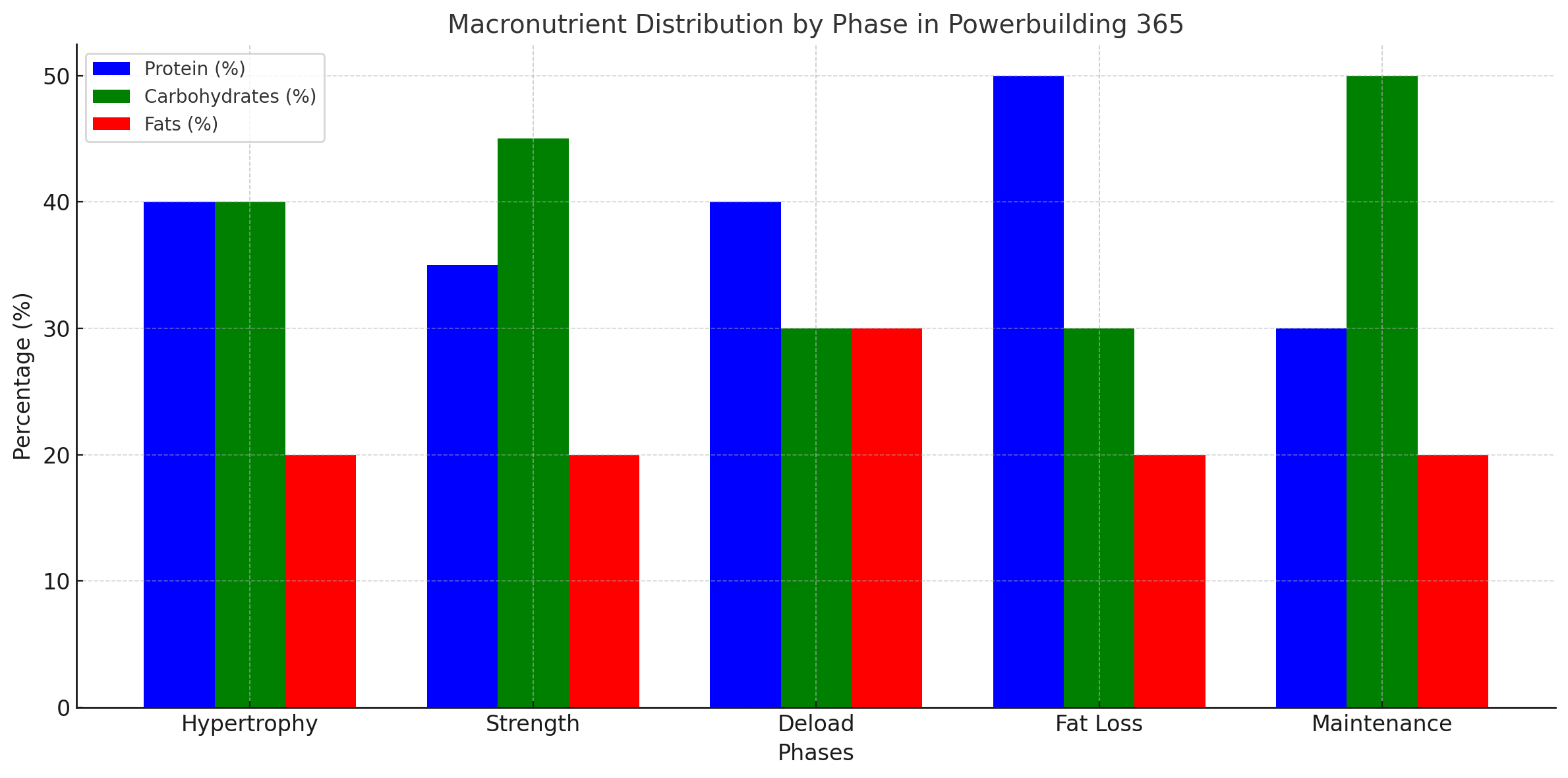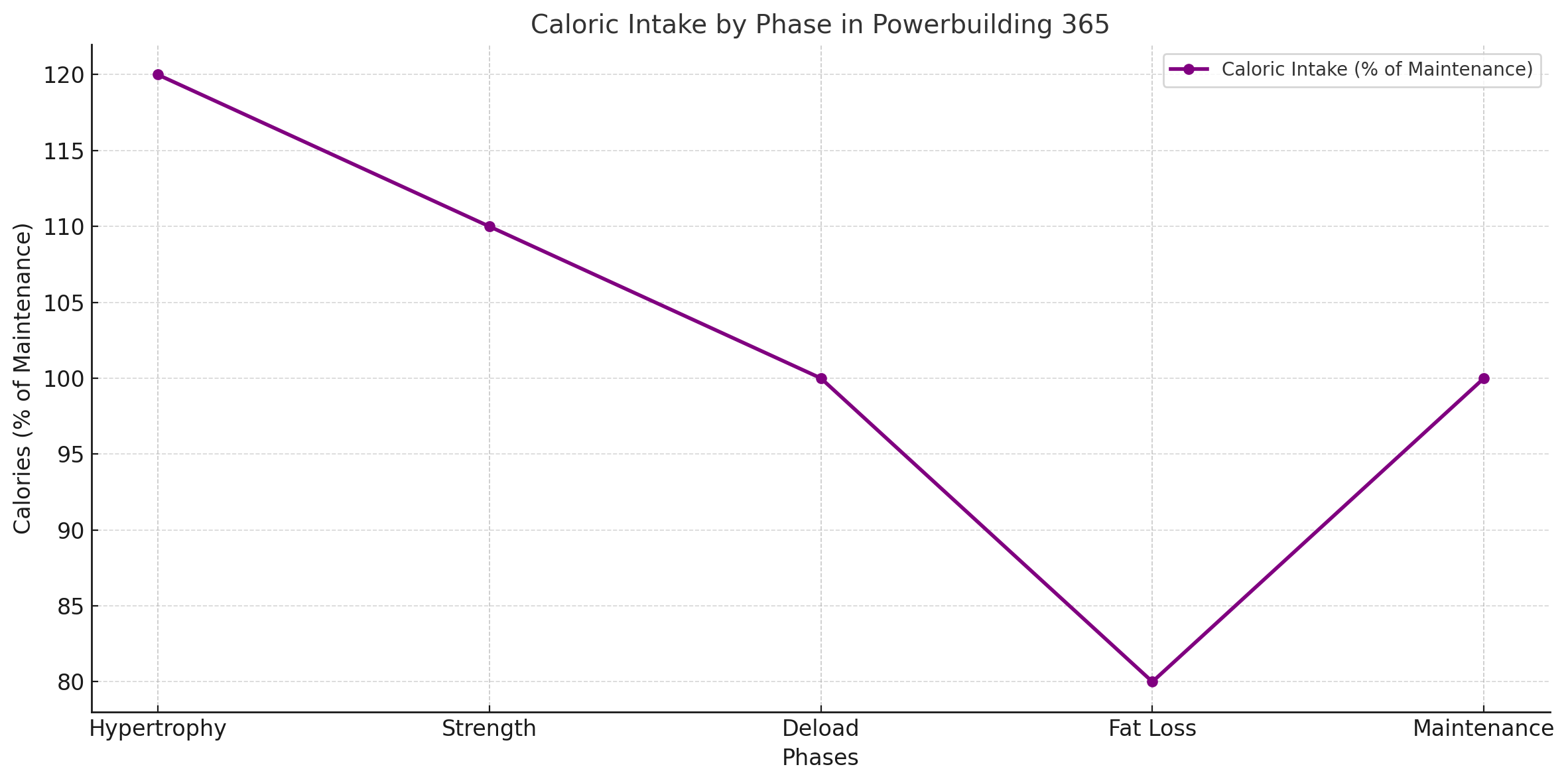POWERBUILDING 365: THE ULTIMATE TRAINING SYSTEM
Own the proven system that blends hypertrophy, strength, and recovery for consistent results.
Our flagship program blends hypertrophy and strength training for advanced lifters. Designed for year-round results, this program helps you build muscle and strength with a science-backed structure.
What is POWERBUILDING 365?
POWERBUILDING 365 is your complete system to building strength and muscle year-round. Designed for advanced lifters, this program adapts to your progress and provides a structured approach to hypertrophy, strength, and recovery.
POWERBUILDING 365 is structured into three essential phases: Hypertrophy, Strength, and Deloading—designed to ensure balanced growth, power, and recovery. The chart below shows how these phases are proportionally distributed across the program.POWERBUILDING 365 is structured into three essential phases: Hypertrophy, Strength, and Deloading—designed to ensure balanced growth, power, and recovery. The chart below shows how these phases are proportionally distributed across the program.
Training Statistics
Key Components
1. Which component takes up the largest portion of Powerbuilding 365, and why is this critical?
Answer: This chart shows Hypertrophy at 50%, indicating it’s the most emphasized phase because muscle growth serves as the foundation for both aesthetics and strength.
2. Why does the Deload phase take up such a small slice (10%) compared to Hypertrophy and Strength?
Answer: The Deload portion of the pie represents its limited time in the program, as it is focused solely on recovery and maintenance rather than active progression.
3. How does the Strength phase balance the program at 40%?
Answer: The chart shows that Strength is the second-largest phase, reflecting its role in building power and complementing the hypertrophy efforts with raw lifting capacity.
4. What does the even split between Strength (40%) and Hypertrophy (50%) indicate about the program’s balance?
Answer: The program prioritizes both size and strength equally, with slightly more emphasis on growth to enhance lifting capacity.
Breakdown by Training Focus
1. Which phase has the highest focus on Volume, and how is it represented visually?
Answer: The graph shows Volume peaking at 70% during the Hypertrophy phase, depicted by the tallest bar for Volume in this phase. This reflects the heavy workload needed for muscle growth.
2. Why does Intensity peak in the Strength phase, and how is it visually represented?
Answer: The graph shows Intensity at 60% in the Strength phase, the tallest bar for Intensity, representing the focus on heavy, low-rep lifts to maximize power.
3. Which phase shifts the focus most heavily to Recovery, and how does this benefit the program?
Answer: Recovery peaks at 70% in the Deload phase, shown as the tallest Recovery bar, signifying its purpose of repairing muscles and preparing for the next training cycle.
4. How does the graph show Volume reducing between the Hypertrophy and Strength phases?
Answer: The Volume bar drops from 70% in Hypertrophy to 30% in Strength, visually reflecting a deliberate reduction to prioritize heavier lifts and fewer reps.
5. How does the Deload phase differ in focus from the Hypertrophy and Strength phases?
Answer: The Deload bars show minimal focus on Volume (10%) and Intensity (20%) but a significant increase in Recovery (70%), emphasizing rest and rejuvenation.
Intensity Progression Over Time
1. Why does intensity increase gradually during the program?
Gradual progression prevents burnout and ensures that the body adapts to increasing effort. It builds strength and muscle efficiently without risking overtraining.
2. What happens during Weeks 9 and 10 (Deload Phase)?
Intensity drops significantly to allow recovery and prepare for the next training cycle. This phase is critical for preventing fatigue and injuries.
3. How does intensity differ between Hypertrophy and Strength phases?
Hypertrophy focuses on moderate intensity (60-90%), while Strength peaks at 75-95%, prioritizing heavier lifts and lower reps.
4. Why is progressive intensity important for advanced lifters?
It ensures continuous adaptation and strength gains while reducing the risk of plateauing, a common issue for experienced lifters.
Training Goal Prioritization
1. Which phase emphasizes size the most, and why?
The Hypertrophy phase (80% focus on size) prioritizes muscle growth with higher reps and moderate weights.
2. Why are multiple Deload phases included in the program, and how are they strategically placed?
Deload phases are placed at strategic intervals to optimize recovery, prevent overtraining, and maintain performance during Hypertrophy and Strength phases. They allow lifters to continue progressing without burnout.
3. How does the Strength phase differ in its goals?
The Strength phase shifts focus to 70% strength, using heavier loads and lower reps to increase power and performance.
4. How do the program’s goals shift over time?
Powerbuilding 365 transitions from muscle growth in Hypertrophy (80% size), to power in Strength (70% strength), and recovery during Deload phases (100% recovery) to ensure consistent progress.
5. Can lifters expect both size and strength gains from the program?
Yes, as the program strategically balances size (Hypertrophy phase) and strength (Strength phase) for comprehensive results while incorporating necessary recovery through Deload phases.
General Questions and Answers
Why does the Hypertrophy phase prioritize volume over intensity and recovery?
Answer: The Hypertrophy phase focuses on high volume (70%) to maximize muscle fiber recruitment and stimulate growth. Moderate intensity ensures consistent effort without overtraining, and recovery is kept low to maintain progressive overload.
2. How does the Strength phase balance intensity and recovery to maximize results?
Answer: The Strength phase emphasizes high intensity (85%) to build raw power, with moderate recovery (15%) to sustain performance. Volume is reduced to focus on heavy lifts with fewer reps.
3. Why is recovery so important during the Deload and Maintenance phases?
Answer: Recovery peaks at 60% in Deload and 40% in Maintenance to repair muscles, prevent overtraining, and prepare the body for the next Hypertrophy or Strength cycle. This ensures consistent progress and reduces injury risk.
4. How does Powerbuilding 365 support fat loss during its dedicated phase?
Answer: The Fat Loss phase incorporates balanced volume (50%) and intensity (40%), with a focus on caloric deficit and strategic recovery (10%). This approach ensures muscle preservation while maximizing fat loss.
5. Why are muscle growth and strength gains split between different phases?
Answer: Muscle growth (80%) is the primary goal of the Hypertrophy phase, providing the foundation for strength gains. The Strength phase shifts focus to building power (90%) by capitalizing on the muscle built earlier.
6. What makes Powerbuilding 365 effective for both aesthetics and performance?
Answer: The program combines high-volume Hypertrophy for muscle growth, high-intensity Strength training for power, and strategic recovery phases to maintain balance. This ensures simultaneous improvements in size, strength, and endurance.
7. How does the graph demonstrate the strategic flow of Powerbuilding 365?
Answer: The graph shows how volume, intensity, and recovery shift across phases to align with specific goals like muscle growth, strength, or fat loss. This strategic design ensures lifters achieve results efficiently while minimizing burnout.
Nutrition
Macronutrient Distribution by Phase (Bar Chart):
This graph illustrates the proportion of protein, carbohydrates, and fats in each phase:
Hypertrophy Phase: Balanced macronutrients to support muscle growth.
Strength Phase: Increased carbohydrates for energy during heavy lifts.
Deload Phase: Higher fats to support recovery while reducing carbohydrates.
Fat Loss Phase: High protein to preserve muscle, reduced carbs to create a caloric deficit.
Maintenance Phase: Balanced macronutrients for long-term sustainability.
Caloric Intake by Phase (Line Chart):
This graph shows how caloric intake fluctuates:
Hypertrophy Phase: 10-20% surplus to fuel muscle growth.
Strength Phase: Maintenance or slight surplus for performance.
Deload Phase: Maintenance for recovery without overloading.
Fat Loss Phase: 20-25% deficit to reduce body fat.
Maintenance Phase: Maintenance to stabilize weight.
POWERBUILDING 365 is a meticulously designed system that combines training progression and nutrition strategies to optimize muscle growth, strength, recovery, and fat loss. The program’s adaptability ensures that each phase—whether focused on hypertrophy, strength, or fat loss—aligns with specific performance and physique goals. By pairing smart caloric adjustments with strategic macronutrient distributions, Powerbuilding 365 delivers sustainable, science-backed results for advanced lifters.
Buy now to start your transformation into a stronger and more confident version of yourself.
“I’m already seeing results! P365 not only helps me to build up muscle but pushes me past what I thought I could do!”

